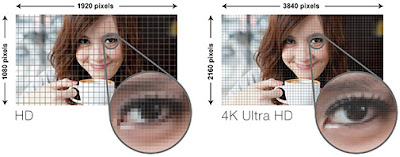But, you might be wondering, what exactly is 4K and why is it something you should care about? Well, we’re going to cover exactly that here and give you an overview of all the critical information about 4K ultra-high definition that you need to know as a potential buyer.
What Exactly Is 4K?
4K, officially known as UHD (Ultra-High Definition), is an overarching term that encompasses visual resolution technology which offers more pixels than regular HDTV (at least 4 times more pixels and thus the name 4K). The ultimate result of this increased pixel breakdown is a an image clarity that goes well beyond conventional 1080 pixel HD resolution and presents more vibrant, varied and realistic colors as well as much higher frame rates.
Currently, the best display of UHD technology is the 4K resolution TV and many of these have been emerging on the market since mid-2013, although 4K monitors have been around since 2013 and 4K resolution film and photo cameras commercially since at least 2012.
4K display has to consist of at least 3,840 pixels (horizontal) x 2,160 pixels (vertical) of resolution and the horizontal can go above 4,000 pixels. This puts it on the top of the current scale of digital resolutions in which the bottom is occupied by standard definition TV (450X540 pixels), HD with 720 pixels and full HD at 1080p.
As you can see, 4K outstrips its best HD predecessor by a very wide margin in creating a resolution profile that’s two times wider and two times higher than 1080 HD, thus giving a total screen resolution that’s 4 times larger overall, thus its name, 4K or, as it used to be called, Quad HD.
 |
| Resolution Compared |
4K and UHD, Differences?
Now, we’ve been using the terms 4K and UHD interchangeably so far and while they basically are interchangeable at the commercial level, they do actually also mean slightly different things. While most UHD that you’ll find on TV screens is actually 3,840 pixels as mentioned above, it still gets called 4K because it does after all offer 4 times the resolution profile of regular HD.
However, in a more specialized context, proper 4K is what is most often found as a digital camera resolution standard that involves an actual 4,096 x 2160 pixel resolution at an aspect ratio of 1.9:1 (horizontal: vertical) as opposed to common TV based 3,840p width and aspect ratios of 16:9 or 1.78:1.
Basically, regardless of the fact that 4K TV is officially defined as UHD, you’re buying into the same thing whether you see either 4K or Ultra HD used to describe a TV, monitor or film/Photo camera.
 |
Should I Buy into 4K?
The answer is a pretty definite yes across the board.If you want a video or photo camera that will deliver image and film clarity like nothing you’ve ever created before, then yes, you should buy a 4K camera.
If you’d like a home theater projector that’s ready for the arrival of 4K films and streaming content, then yes, go for 4K, though it will still cost you at least several thousand dollars to get your hands on one.
If you’d like a computer monitor that can render the latest games and UHD web content in the clarity they were designed for, then you should definitely get your hands on a 4K monitor. This applies even more so if you’re a professional designer or architect who’s involved in work that requires extremely detailed rendering of graphics.
And finally, in terms of the most dominant 4K product on the market today, the TV, then if you want to future proof your set for viewing the wide array of 4K entertainment options that will definitely be appearing in the next year or two, you should buy a UHD TV screen from a high quality manufacture. Even if 4K content is slow to arrive in your area, you’ll at least benefit from a wide array of top of the line resolution upconverting, rendering and display technologies which will drastically improve all of your regular HD content much more beautifully.

0 comments:
Post a Comment